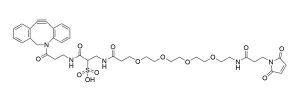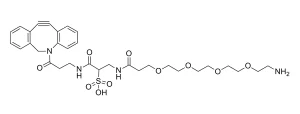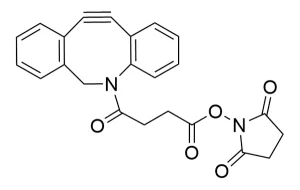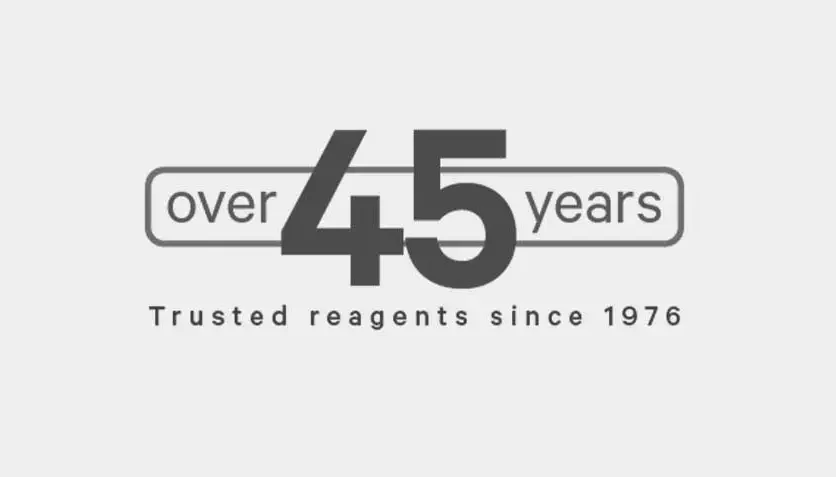Tetra(-dPEG®11-DBCO)pentaerythritol, product number QBD-11371, is a four-armed, discrete polyethylene glycol (dPEG®) crosslinker built around a pentaerythritol core. Each dPEG®11 spacer arm is 43 atoms (47.4 Å) long and terminates with a dibenzocyclooctyne (DBCO) functional group. The DBCO moiety conjugates to an azide-functionalized molecule or surface via strain-promoted azide-alkyne cycloaddition (SPAAC), also known as copper-free click chemistry. This product is useful for supramolecular construction (e.g., dendrimers) and for efficiently crosslinking azide-functionalized proteins or peptides.
This compound showcases the advantages of dPEG® products. Conventional polyethylene glycol (PEG) products are dispersed polymers. These polymers consist of a complex mixture of different chain lengths and molecular weights that make exact analysis and characterization quite challenging.
Vector Laboratories’ dPEG® products contain precisely defined, single molecular weight, discrete-length PEG chains (i.e., they are monodispersed PEG products). Tetra(-dPEG®11-DBCO)pentaerythritol would be challenging to characterize if made with conventional PEG reagents because of polymer dispersity. The synthesis of a product like Tetra(-dPEG®11-DBCO)pentaerythritol using standard PEG reagents creates a complicated assortment of different products. However, using dPEG® reagents, this product can be synthesized and characterized accurately.
| Unit Size | 25 mg, 100 mg |
|---|---|
| Molecular Weight | 3736.451; single compound |
| Chemical formula | C₁₉₃H₂₂₈N₁₂O₆₀ |
| CAS | N/A |
| Purity | > 97% |
| Spacers | dPEG® Spacer data for each arm is 43 atoms and 47.4 Å |
| Shipping | Ambient |
| Typical solubility properties (for additional information contact Customer Support) | Methylene Chloride, Methanol, DMAC, DMF, or DMSO |
| Storage and handling | -20°C; Always let come to room temperature before opening; be careful to limit exposure to moisture and restore under an inert atmosphere; stock solutions can be prepared with dry solvent and kept for several days (freeze when not in use). dPEG® pegylation compounds are generally hygroscopic and should be treated as such. This will be less noticeable with liquids, but the solids will become tacky and difficult to manipulate, if care is not taken to minimize air exposure. |
Greg T. Hermanson, Bioconjugate Techniques, 2nd Edition, Elsevier Inc., Burlington, MA 01803, April, 2008 (ISBN-13: 978-0-12-370501-3; ISBN-10: 0-12-370501-0). Specifically see pp. 726-729 in his Chapter 18 on discrete PEG compounds for pegylation applications.
Greg T. Hermanson, Bioconjugate Techniques, 3rd Edition, Elsevier, Waltham, MA 02451, 2013, ISBN 978-0-12-382239-0; See chapter 18, Discrete PEG Reagents, pp.787-821, for a full overview of the dPEG® products.
Applicable patents and legal notices are available at legal notices.




Stay in the Loop. Join Our Online Community
Products
Ordering
About Us
Application
Resources

©Vector Laboratories, Inc. 2025 All Rights Reserved.
To provide the best experiences, we use technologies like cookies to store and/or access device information. Consenting to these technologies will allow us to process data such as browsing behavior or unique IDs on this site. Not consenting or withdrawing consent, may adversely affect certain features and functions. Privacy Statement
How do I Request a Quote?
To request a quote for products: